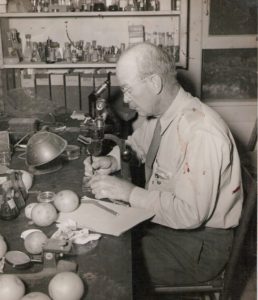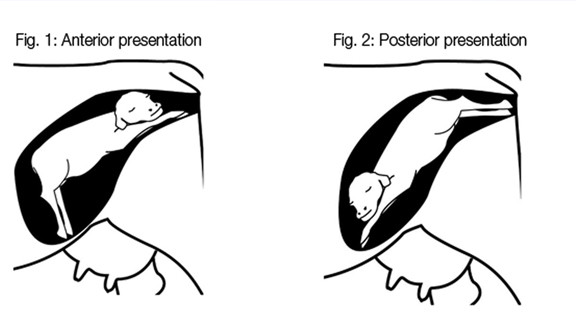Farm & Ranch
[AgriLife Today] Agriculture tells the history of the Rio Grande Valley

By: Rod Santa Ana
Writer: Rod Santa Ana, 956-878-8317, r-santaana@tamu.edu Contact: Dr. Luis Ribera, 956-373-5086, lribera@tamu.edu
WESLACO — As the 1800s rolled into the 1900s, agriculture in the Lower Rio Grande Valley was in the midst of a major makeover, according to local historians and agricultural experts.

Dr. George H. Godfrey, the first plant pathologist in the Rio Grande Valley is shown in the early 1950s working at the then-Rio Grande Valley Experiment Station, now the Texas A&M AgriLife Research and Extension Center at Weslaco. (Photo courtesy of Rod Santa Ana)
It was changing from a livestock economy to one of irrigated farming that would eventually fuel unprecedented growth in South Texas, said Dr. Luís Ribera, a Texas A&M AgriLife Extension Service agricultural economist in College Station.
“The height of the Spanish colonial livestock economy in the Valley lasted roughly from 1770 to 1900,” Ribera said. “It was too dry to grow crops in large quantities, so the economy was based on selling standing cattle and cattle by-products to Mexico.”
Ranches sprouted and flourished in the mid-1700s because of Jose de Escandón, a Spaniard sent to the area by Spanish authorities in Mexico City. He and his followers, the Valley’s pioneers, mapped and settled the fertile region on both sides of the Rio Grande, then known as Seno Mexicano, said Karen Fort, a local historian and co-author of Images of America: Hidalgo County, Texas.
“Escandón succeeded in his task far beyond expectations in this rugged country and renamed it Nuevo Santander after his native Santander Province in Spain,” she said. “Six thousand Spaniards answered the call to settle the land here, and within five years, Escandón had established 24 villages, 15 missions and 20 ranches, complete with almost 90,000 head of cattle.”
That laid the foundation for the settlement of the Lower Rio Grande Valley and the ranching empire that would dominate the land for the next 150 years, Fort said.
“Efforts to irrigate parched corn fields near his settlements ended in failure because Escandón just didn’t have the technology to lift water up and over the high banks of the Rio Grande. Instead, crops were planted when floods subsided or in river bottoms. Away from the river, ranchers dug deep wells that were hand-operated 24 hours a day to water small crops and keep livestock troughs full,” she said.
International law invites outsiders
After the Treaty of Guadalupe Hidalgo in 1848 formalized the national boundary at the Rio Grande, extranjeros, or foreigners, began moving into the area from Europe, marrying into local families and assimilating into the Mexican culture where little or no English was spoken until the early 1900s, Fort said.
“And by the end of 1910, most of the components were in place to begin the next phase of agriculture — irrigated farming,” she said. “These included the centrifugal pump, the railroad, electricity, improved farming implements and what was then the largest private irrigation system in the world that helped land companies entice farmers from the Midwest to farm here.”
Between 1900 and 1910, 50 steam-engine pump houses had been built along the Rio Grande to irrigate farmland. At their height, they irrigated 1 million acres of farmland as land prices soared from 25 cents per acre in 1906 to $300 per acre in 1910, Fort said.
“Back-breaking farm labor was provided by landless locals as well as hundreds of thousands of Mexicans who were fleeing the violent and bloody Mexican Revolution of 1910 that ended the 34-year dictatorship of Porfirio Díaz,” she said.
On Oct. 6, 1923, a telegram from College Station arrived in what would soon become the city of Weslaco to advise local farmers that they had succeeded in their efforts to establish an experiment station to conduct scientific research on local crops and extend that information to growers, Fort said.
The experiment station was originally known as Substation No. 15 and immediately began research under the direction of the state’s land-grant college, Texas A&M University, then known as Texas Agricultural and Mechanical College, said Dr. Jose Amador, center director emeritus and one-time director of the Texas A&M AgriLife Research and Extension Center in Weslaco and the Texas A&M-Kingsville Citrus Center.
“The original emphasis was to find solutions for the many problems that plagued citrus, but by 1925 their research included tests on lettuce, spinach, turnips, carrots, beets, cabbage, cauliflower, corn, grapes, beans, cotton, soybeans, sugarcane and various fruits,” he said.
An annual report from Substation No. 15 in 1927 reported problems with root rot, freezes, hurricanes, salty river irrigation water and marketing.
“Insects and plant diseases seem to thrive in this climate and have taken their toll,” the report noted.
Local producers start making big bucks
Despite cyclical and persistent adversities, including uncooperative weather, poor market prices, rising production costs, insect pests and diseases, growers and the labor force persisted, Amador said.
“Despite those difficulties, agriculture here thrived; many growers made handsome profits that allowed them to pay off their land loans in short order,” he said.
The central turning point in developing the Rio Grande Valley hinged on the expanding irrigation system fed by water from two huge upstream dams and favorable water treaties with Mexico in the 1940s, said Dr. Merritt Taylor, a former economist at the AgriLife center in Weslaco and now a research center director in Lane, Okla.
“Freezes caused many land investors and farmers over the years to abandon their efforts here, which allowed the land to be resold to new investors. The strong pushed out the weak and got stronger,” he said.
Each wave of investors brought with them a new influx of money, people from the north, new equipment and new ideas, Taylor said.
The first carload of grapefruit was shipped from McAllen in 1915 and by the mid-1950s, acreage had grown to 120,000 acres of citrus. But freezes, urbanization and other factors have reduced that number to about 30,000 acres today, Amador said.
“A mild climate allowed for a year-round growing season that allowed for all kinds of crops to be grown here, but the mainstays have been vegetables, citrus, sugarcane, cotton and grains,” he noted.
Weslaco Center boosts state, local vegetable production
The Texas A&M center’s “golden era of vegetable breeding,” a highly specialized technology, is responsible for a large segment of the progress in Texas agriculture, said Dr. Ben Villalón, a retired pepper breeder at the Weslaco center and professor emeritus.
“For over 90 years in the Valley, one of the richest farming areas of Texas, scientists have solved some of the toughest problems with citrus, fruits, over 60 different vegetables and many agronomic crops, including cotton, corn, sorghum and sugarcane in the state’s only subtropical region,” Villalón said.
The search for genetic resistance to insects and diseases in vegetables began in Weslaco in the late 1930s by Dr. S. S. Ivanoff, who eventually released a cantaloupe resistant to melon aphids and downy mildew. He was the first of a long string of highly successful vegetable breeders who developed improved varieties still grown all over the world, Villalón said.
“Dr. George H. Godfrey, the first plant pathologist at the A&M center, developed the first downy and powdery mildew resistant cantaloupes in 1950, followed by the release over the next 35 years by Prof. Rumaldo T. ‘Mayo’ Correa of 15 superior cucurbit genotypes, including cantaloupes, watermelons, cucumbers, honey dews and casabas,” Villalón said.
“Between 1952 and 1985 Prof. Paul W. Leeper gained national acclaim by breeding superior tomato, lettuce and onion releases. His onion breeding work eventually led to several disease-resistant sweet, early onion varieties, including the world-famous 1015 onion.”
Villalón himself was among the center’s prolific vegetable breeders, releasing a host of viral resistant peppers that did not exist before 1970, including the world’s first mild jalapeño pepper. It would revolutionize the salsa picante industry, Amador said.
“Suddenly, mild salsas were made available to the public who consumed them at such a rate that by 1990 salsa outsold ketchup as the favorite condiment in the U.S.,” Villalón said. “Capsicums (peppers) have been around for 8,000 years, but in just 30 years we made tremendous genetic improvements to them that continue today under the direction of Dr. Kevin Crosby at Texas A&M AgriLife in College Station.”
Then-U.S. Congressman and chairman of the House Agriculture Subcommittee Kika de la Garza often referred to Villalón as “the man who tamed the mighty jalapeño,” Amador said.
Cotton becomes king
One of those stronger mainstays, cotton, was probably first produced in the area in the mid-1800s and continues to this day, but not without its problems, said John Norman, a retired AgriLife Extension entomologist in Weslaco and now a private consultant.
“Poor market prices, drought, flood, hurricanes and insects have all taken their toll on cotton here in the last 125 years or so,” he said.
Cotton acreage peaked in 1951 after a January freeze nearly wiped out citrus, similar to what happened in 1983 and again in 1989, Norman said.
“Instead of immediately bulldozing out the dead citrus trees, many farmers planted cotton between the rows of dead trees, adding significantly to what is now considered to be the high period of cotton production in the Rio Grande Valley,” Norman said.
“Officially, the acreage was recorded at 880,700 acres, but some estimates put the number closer to 1 million acres. All the other years, from 1947 to 1963, averaged about 450,000 planted acres.”
Cotton acreage, as well as cotton gins, has declined over the years, Norman said.
“Lately, cotton averages about 100,000 acres,” he said. “And the number of active gins has declined from 107 gins in 1952 to about 10 today.”
On the positive side, Valley cotton producers have broken previous records of per-acre yields three years in a row beginning in 2014.
“We went from 1,032 pounds of lint per acre in 2014 to 1,118 pounds in 2015 and 1,128 pounds per acre in 2016,” Norman said. “The previous highest yield per acre was about 860 pounds back in 1984. And all of this is due to improved cotton varieties and a very successful boll weevil eradication program that has completely prevented crop damage from that insect.”
Poor market prices and the higher cost of cotton production in the U.S. as compared to China and other countries have forced many Rio Grande Valley farmers to change the crops they grow, he said.
“Changes in technology will likely be the driving force behind how much or little cotton continues to be planted,” Norman said. “The same is probably true for every crop now grown in the Valley.”
Sugarcane elbows its way back in
Sugarcane, another storied Valley crop, was first grown in the region in 1858, according to Norman Rozeff, a retired agronomist at the sugar mill in Santa Rosa and a local historian.
“The last turn-of-the-century sugar mill in Donna ceased to operate in 1922,” he said. “It wasn’t until 1972 that the sugarcane industry resumed here in the Valley. Farmers were looking for an alternative to planting low-priced cotton and first considered raising sweet sorghum.”
After exhaustive tests at the AgriLife Research center in Weslaco led by agronomist and long-time center director Raymond Cowley to find a suitable alternative, growers settled on sugarcane, he said.
“Over 100 farmers formed a cooperative and built what was then the world’s most modern processing factory, setting the standard for sugarcane industry modernization in the world. And despite weather-related setbacks from time to time, the sugar cooperative has flourished for over 40 years and been a sizeable economic plus for the Valley,” he said.
“Mr. Cowley, an agronomist by training, insisted that sugarcane was a more suitable crop for the Valley than sugar beets and he was right,” Amador said.
Cowley and Amador, a native of Cuba and the only scientist in Weslaco with any experience growing sugarcane, traveled to cane-growing areas, including Louisiana, Florida and Mexico, in search of suitable sugarcane varieties for the Valley.
Unlike the cotton industry, sugarcane acreage has increased measurably over the decades, thanks to accumulated knowledge of the plant’s husbandry, increased yields and constant mill modernizations, Rozeff said.
“The average cane industry here is presently over 40,000 acres and the average yield has risen to well over 3 tons of sugar per acre,” he said. “Sugarcane has been a good fit for the Valley and with the use of bagasse — the fiber left after the cane is ground — to generate electricity, it now takes its place as a ‘green’ renewable resource. This is certainly a goal the community obviously wants to pursue.”
Valley’s billion dollar ag baby here to stay
While its heyday may be behind it, the Rio Grande Valley’s crops, livestock and ag-related businesses continue to have an annual statewide economic impact of about $1.1 billion, Ribera said.
“Urbanization and the implementation of NAFTA (North American Free Trade Agreement) in 1995 had a profound effect on irrigated farming,” he said. “Trade, retail sales and maquiladora manufacturing now overshadow the income of agriculture here.”
While agriculture is worth $584 million in gross sales, retail store sales now account for some $7 billion annually, Ribera said.
Dr. Juan Landivar, director of the Texas A&M AgriLife Research and Extension Centers at Weslaco and Corpus Christi, said despite its drop in prominence and the persistence of challenges, agriculture is here to say.
“Our geographical location as a border state, as well as the increase in agricultural commerce across our ports of entry, open the door to invasive weeds, insects and vector-transmitted diseases that can infest our agricultural fields,” he said. “In addition, global warming threatens to increase our already high summer temperatures, increase water use and losses, and add a few generations of pests to our cropping system.”
Landivar said new scientific technologies, including biotechnology, genetic-marker assisted plant breeding and the use of modern scientific molecular tools, would result in the development of new, resilient cultivars adapted to changing weather conditions and resistant to evolving pests and diseases.
“These new cultivars and the advent of remote sensing and the use of unmanned aerial vehicles, or UAVs, are opening the door to a new dimension of precision management of crops better suited to deal with threats,” he said. “These tools, developed by Texas A&M AgriLife and others, will also continue to play a role in the future of agriculture in South Texas.”
Landivar said the spirit of South Texas farmers will prevail.
“As long as we conserve and use judiciously our water supply and protect our soils from erosion and other mismanagement, there will be a place for agriculture here,” he said. “Farmers here are resourceful, resilient and devoted. They will always find a way to produce crops better than anyone else.”
Find more stories, photos, videos and audio at http://today.agrilife.org
Farm & Ranch
What to expect when your cow’s expecting

Overweight cattle and cattle turned out on lush legumes with high concentration are at risk as well. In this case, an epidural anesthetic is usually necessary. The tissue will need to be replaced and sutured in place. Vaginal sutures will need to be removed prior to calving.
Toxemia happens when cattle are exposed to low nutrition during the last two months of pregnancy. Cows that are overly fat and/or carrying twins are at higher risk. Cows with toxemia become depressed, stop eating and often stand off away from the herd. You will notice some have the scent of acetone on their breath. As the condition worsens, the cow may develop muscle tremors. Treatment for toxemia is IV glucose, B vitamins or propylene glycol given by oral drench.
During calving there are a number of problems that could occur. Those include dystocia, bruises and lacerations to the birth canal, uterine prolapse, milk fever, retained placenta and grass tetany.
According to the Beef Cattle Handbook, a product of Extension Beef Cattle Resource Committee Adapted from the Cattle Producer’s Library, at any time a cow is unable to deliver her calf, a dystocia has occurred. There are many things a producer can do to reduce this incidence. With heifers, lot those with small pelvic areas before breeding. Select bulls based on their birth weight, not on their relative size. Ultimately use bulls that will produce small birth-weight calves. When calving first-calf heifers separate them from cows, at best into small groups. Producers will want to provide surveillance over the heifers on a 24 hour basis. Some tips include restricting the calving to 42 to 60 days. That will enable personal focus for a short, intense calving period. Also feeding at night between 9 and 11 p.m. will cause more animals to calve during daylight hours.
If problems arise and a cow hasn’t shown progress in 60 to 90 minutes, it’s time for the producers to step in. Signs of an abnormal delivery are the head only, the head and one leg, one leg alone or the tail. At this point it is best to contain the animal in a squeeze chute or small pen. A calf can only deliver one of two ways: both front feet followed by the head or both back feet out together. Once constrained, using ample lubrication, a producer can reach in and move the calf to one of the two correct positions. If unable to do so, a veterinarian should be called. The top problems include not getting the head out with front feet, having a calf too big to deliver through the mother’s birth canal resulting in hip lock and abnormal breach in which the tail is the only part of the calf visible through the vulva. If all goes well and pulling the calf is suggested, direct traction down and away from the birth canal. Do not pull straight out behind the cow. If two men are unable to pull the calf using the OB chains or when using the calf puller, do not use excessive force. It will not deliver the calf. Odds are the cows birth canal is too small for the calf and will result in a c-section.
Keep in mind bruises, lacerations and rupture of the birth canal are possible during a difficult birth. Rough handling of the calf or maternal tissues and careless use of obstetrical instruments during calving add danger. This is typical when a cow is in labor several hours with a dry, non-lubricated birth canal.
Cows with difficult delivery and trauma to the tissue and birth canal may have damage to the nerves and spinal cord or hips that supply the legs. This results in abnormal leg function. In some cases, while pulling a calf, excessive force was used and the middle lower pelvis bones were fractured. At this point steroids are administered to help with swelling and nerve healing. In bad cases were the cows are unable to stand, they need to be hoisted to their feet twice a day.
In older cows producers may see difficulty in birth injury or irritation of the external birth canal and severe straining, retained placenta and loose uterine attachment in the abdominal cavity called uterine prolapse. When noticed, this condition needs immediate action. Apply material to uterine wall to saturate fluid ASAP. You can use sulfaurea powder, urea powder or even sugar. Replace the uterus immediately or call your veterinarian. Without properly replacing the uterine horns, prolapse will reoccur.
Usually the placenta is passed in three to eight hours. If the placenta hasn’t passed in eight to 12 hours of calving, the placenta is retained and the cows must be treated. A number of reasons lead to retained placenta: dystocia, c-sections, fetotomy, twinning or abortion along with other infectious diseases. Even feed deficiencies, malnutrition, low carotene, vitamin A, iodine, selenium and vitamin E can be to blame. To treat, use slight, manual force and gently pull on the placenta. If it resists, stop and pack the uterus with boluses or fluid douches to keep antibiotics in the uterus. As with prolapse, be sure to use proper hygiene when treating the uterus or worse problems will occur.
Another condition parallel with cows with age, number of calves and dairy or mixed breeds is milk fever. This condition happens when a cow starting to produce milk is unable to remove calcium from her bones quickly enough. If blood levels of calcium fall below the minimal level, the muscles of the body are unable to function. This leaves the cow almost crippled, comatose and dead. High blood levels of estrogen inhibit calcium mobilization; this may be a factor on pastures that are high in legumes. Usually a slow administer of IV calcium is given. 300 to 500 ml of a commercial calcium solution is given over 20 to 30 minutes.
Lastly, grass tetany poses as an issue to cows calving. It is similar to milk fever, but in this instance cattle have heavy post-calving lactation and lose large amounts of magnesium in their milk. Most types of mixed pasture grasses are low in magnesium. If cows are exposed to cold weather or stress during early lactation, their blood levels may drop low enough to cause grass tetany. At that point an IV of magnesium is given with calcium. Treatment is not as effective as with milk fever and in many cases, animals do not respond.
This article was originally published in the January 2016 issue of North Texas Farm & Ranch.
Farm & Ranch
Managing Show Cattle Through The Winter

By Heather Welper
Husband and wife duo, Heather and Calvin Welper, are the Co-Owners and Operators or Two C Livestock, located in Valley View, Texas.
The pair’s operation has a show cattle focus where they raise and sell purebred heifers of all breeds and club calf Hereford steers.
When it comes to show cattle, the Welpers know a thing or two including how to prepare for the cold winter months and the Texas major show season run.
To read more, pick up a copy of the November edition of North Texas Farm & Ranch magazine, available digitally and in print. To subscribe by mail, call 940-872-5922.

Farm & Ranch
Double M Ranch & Rescue

By Hannah Claxton, Editor
As the sun rises each day, so do the dozens of mouths that Meghan McGovern is responsible for getting fed. Rather than the sounds of a rooster crowing, McGovern hears the bellows and bleats of a variety of exotic deer, the chortle of kangaroos, the grunts of water buffaloes, and the chirps of a lemur.
Nestled against the banks of the Red River, the Double M Ranch and Rescue, with its high game fences and deer sprinkling the landscape,s its in stark contrast to the surrounding ranches.
“Having deer is kind of like eating potato chips- you can never actually have just one,” said McGovern with a laugh.
McGovern has several herds to take care of- fallow deer, axis deer, water buffalo, goats, and bison. In smaller numbers, there’s also a few kangaroos, a lemur, a potbelly pig, a pair of zebras, a watusi, and a few horses.
To read more, pick up a copy of the November edition of North Texas Farm & Ranch magazine, available digitally and in print. To subscribe by mail, call 940-872-5922.

-

 Country Lifestyles2 years ago
Country Lifestyles2 years agoScott & Stacey Schumacher: A Growth Mindset
-

 Country Lifestyles8 years ago
Country Lifestyles8 years agoStyle Your Profile – What your style cowboy hat says about you and new trends in 2017
-

 HOME8 years ago
HOME8 years agoGrazing North Texas – Wilman Lovegrass
-

 Outdoor10 years ago
Outdoor10 years agoButtercup or Primrose?
-

 Country Lifestyles9 years ago
Country Lifestyles9 years agoJune 2016 Profile – The man behind the mic: Bob Tallman
-

 Country Lifestyles8 years ago
Country Lifestyles8 years agoDecember 2016 Profile, Rusty Riddle – The Riddle Way
-

 Horsefeathers11 years ago
Horsefeathers11 years agoMount Scott: Country Humor with David Gregory
-

 Country Lifestyles5 years ago
Country Lifestyles5 years agoAmber Crawford, Breakaway Roper




